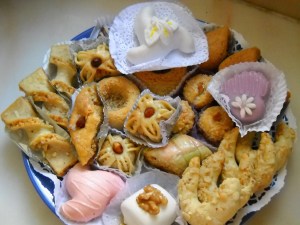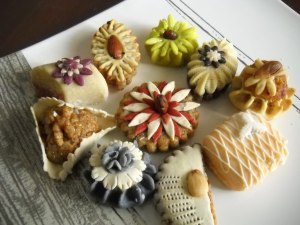algiers: the food
You thought I was done with my posts about Algeria, didn't you? But how could I have gone to North Africa in Ramadan and come back not say anything about the food?
Generally, North African cuisine is quite different from Middle Eastern, but then that is the case with everything not just the food. It tends to be a little simpler with less use of spices and occasionally, a little bland for an Asian palate like mine. But the vegetables are almost always fresh and bursting with natural flavour. The history of the region, it's heritage and culture has a range of facets to it. Even amongst the Algerians, there are certain things that families do differently from each other based on their backgrounds and experiences. Most of the older generation was directly involved in war. Many families left their towns and villages and moved to Algiers, the capital city, bringing with them their personal traditions. So the same dish may have a few different names or the method used to prepare it is different from the way it's done by another family from another area. But there are some things that most people do, pretty much the same way. Breakfast is usually hot milk, with coffee and bread, croissants, biscuits or anything like that. Every day at around 'Asr time (around 4pm) the smell of strong coffee fills homes (and even streets) and there is always something to go with the coffee. All families will have bag-loads of bread for the day or home-made breads and lots of it.
Of course the Maghreb region is known for it's couscous. But the dish is usually reserved for special occasions. My mother-in-law makes it at home from scratch and by "from scratch" I mean she forms the little grains herself. Of course she made plenty of it for us to bring back, but not with the usual semolina. This time she made it with wheat.
We were also gifted the light pastry sheets (Ftir) that are ripped up in to smaller pieces, steamed and served with a broth (like the one made for couscous), otherwise known as Shakhshoukha. Then there were the thin strips of semolina dough (Rishta) which is just a like a lighter fettucini. None of these dishes are generally served in Ramadan though. Ramadan is different!
Some may eat sweet couscous with raisins for suhoor, but that's about it. After breaking the fast, they tend to opt for lighter dishes like a little meat cooked with carrots and olives or chicken cooked with potatoes (well, chips really, they do eat a lot of chips!). But the fast is always broken with Algerian soup or Shorbah and Borek (the Algerian spring roll). Of course some might deviate from this and cook different soups and while I was there, I made samosas upon the request of family members. My sister-in-law shocked us all with Rishta one evening, just because she knows I like it! And my friend over at Seeking Jannah, made rice and curry in my honour ma sha Allah!
Usually, a lot later, after taraweeh, coffee and sweets are served. Some very sweet sweets, I might add. And then comes 'Eid day and all the couscous, rishta, shakhshoukha and other non-bread carbohydrates(!) make an appearance. They, along with many, many sweets!
Some, home-made ...
... and some, shop-bought.
Back in my own little space, I decided to do couscous a little differently.
I steamed some brown couscous with peas. Then I sauted some onions, garlic, prawns and chillies in a little butter and tossed it all together! Traditional dishes are nice sometimes, but I do believe that "variety is the spice of life" and I like mine spicy.










0 comments:
Post a Comment